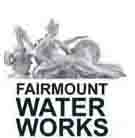
"Here, from 1799 to 1829, stood the old Philadelphia Water Works, surrounded by a fine park, with its interesting pump house designed in the Greek Revival style by Henry Latrobe. (A painting of it by John Kremmell, as it appeared in 1812, is in the Academy of Fine Arts.) Old wooden pipes from this water
system have been unearthed in the course of excavation work for the Philadelphia subway system.
" --- Pennsylvania: A Guide to the Keystone State, 1940; page 279 - 280
Speaking as a pseudo-engineer, this is the site of the first large-scale application of steam pumping, later water power, to public water supply. Speaking as a tourist, this is such a wonderful jewel in the Philadelphia historical crown. I went with the kids and we walked all over, making sure not to miss anything. I was especially impressed with the Geek-influenced architecture, especially of the Pavilions and a few of the primary structures. This architecture is in harmony with the Philadelphia Museum of Art, just up the hill, west of this position. Equally impressive were the various sculpture adorning the myriad buildings. We also found a fountain, a few monuments and memorials and a whole host of interpretives which really do a magnificent job in explaining this historic site. There is also a free interpretive center in which to walk around and get an even more wide and informed lesson on this site. This is definitely a family site. We rested and relaxed on the lawn overlooking the river. People were sunbathing, families were exploring and we just had a great time. The property was posted to the National Register of Historic Places on May 11, 1976. There is a building, 3 structures and 4 objects which contribute to this NRHP site.
Wikipedia tells us: The Fairmount Water Works in Philadelphia, Pennsylvania was Philadelphia's second municipal waterworks. Designed in 1812 by Frederick Graff and built between 1812 and 1872, it operated until 1909, winning praise for its design and becoming a popular tourist attraction. It was placed on the National Register of Historic Places in 1976 and is once again in the process of winning back visitors, now housing a restaurant and an Interpretive Center to aid in understanding the waterworks' purpose and local watershed history. SOURCE
The Fairmount Water Works is perhaps the premier example of early 19th century American industrial architecture. It was built to supply Philadelphia with a reliable source of fresh water. During its operational life the Fairmount Water Works employed a wide variety of hydraulic technologies including steam engines, wooden and cast iron breast wheels, and iron water turbines. Known as the "Mecca of hydraulic engineers" the Fairmount Water Works greatly influenced subsequent municipal water works development throughout the United States. -- Historic American Engineering Record (HAER PA-51) SOURCE
Background
The City of Philadelphia built the Fairmount Water Works in response to the catastrophic Yellow Fever Epidemic of 1793, becoming the first American city to regard the delivery of fresh water to its citizens as a municipal responsibility. Completed in 1815, the Water Works used steam engines to lift water from the Schuylkill River into reservoirs atop the hill where the Philadelphia Museum of Art now stands.
The City replaced the costly and unreliable engines with water wheels in 1822, which helped make the operation profitable. It built gardens and gazebos, and in 1835 converted the steam engine room into a saloon serving refreshments. With its revolutionary blend of architecture, nature and the technological sublime, the Water Works became the second most popular tourist attraction in America by the mid-19th century. Visitors could enjoy the site’s stately, neo-classical architecture, then watch the muscular wheels and pumps at work with a pastoral river scene in the background.
Unfortunately, the Schuylkill River became increasingly polluted by industry, despite the city’s purchase of land that drained into the river. The problem grew worse until the Water Works was forced to close in 1909.
The City soon devised an imaginative re-use for the site, replacing it with an aquarium, which grew to be the fourth largest in the world by 1929. In 1961 a section of the aquarium was converted into a swimming pool with funding from Philadelphia’s illustrious Kelly family. The City closed the Kelly Natatorium in 1972 after it was flooded by Hurricane Agnes.
The pool area and the rest of the Water Works remained vacant for more than a decade. Following a lengthy restoration that began in the 1990s, an Interpretive Center and a fine dining restaurant opened, however the pool area remains closed. SOURCE
The extensive, original nomination form from 1976 can be found HERE. A most excellent history of this site can be found HERE. The Water Works also hosts its own site and goes into detail about the interpretive center, which can be found HERE. Finally, this site is recognized as an engineering landmark. The documentation on that can be foundHERE.